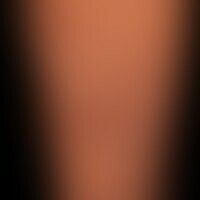Image diagnoses for "red"
877 results with 4458 images
Results forred

Facial granuloma L92.2
Granuloma faciale: The otherwise healthy 37-year-old patient has been noticing this painless, red, smooth plaque for months.

Lupus erythematosus acute-cutaneous L93.1
lupus erythematosus acute-cutaneous: large and small succulent plaques, with sharply defined circulatory borders, which occurred within a week in a previously healthy patient. skin detachment with weeping and crust formation in the sternum area. inflammation parameters significantly increased. ANA: 1:320; anti-Ro/SSA and anti-La/SSB antibodies positive.

Asymmetrical nevus flammeus Q82.5
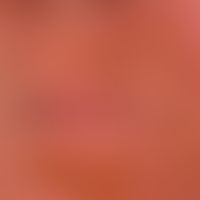
Contact dermatitis allergic L23.0
Contact dermatitis allergic: extensive contact allergic pyodermic contact dermatitis.
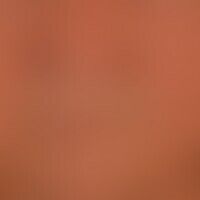
Scleroderma systemic M34.0
Scleroderma, systemic: within 2-3 years, newly developed telangiectasia of the facial skin.

Pemphigoid bullous L12.0
Pemphigoid, bullous. 1 year old, itchy blisters on the left hand of an 82-year-old woman, filled with a yellowish liquid. Some of the blisters have been scratched open by the patient. Overall progressive skin findings, similar efflorescences on upper arms, back and feet.

Light urticaria L56.3

Lupus erythematodes chronicus discoides L93.0
lupus erythematodes chronicus discoides. alopecia existing for 4 years. multiple, smaller and larger alopecic foci, with centrifugal expansion. in the center larger hairless, scarred area (no evidence of follicular structures). the patient complains of a temporary hyperesthesia of the affected areas. encircles a still active zone of CDLE.

Drug reaction lymphocytic T88.7
drug reaction, lymphocytes: multiple, non-symptomatic, surface-smooth papules and plaques. occurred several months after cardiological readjustment. patient otherwise healthy. no evidence of lymphatic systemic disease. no other drugs. histological: nodular, mature lymphocytic tissue. no lymph follicles.

Contagious impetigo L01.0
Impetigo contagiosa. red, erosive, rough, partly crust-covered plaque with rhagades and scaly crusts, persistent for several weeks, resistant to therapy. evidence of Staphylococcus aureus.
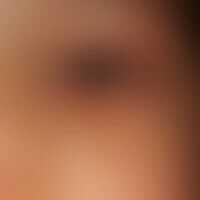
Contagious mollusc B08.1
Molluscum contagiosum: regressing papule at the lower lid margin; note: in this case a conservative therapy is recommended.
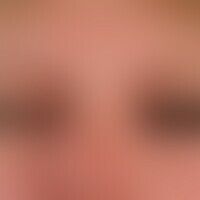
Contact dermatitis (overview) L25.9
Contact dermatitis: Heavily lichenified eczema plaques in the area of the upper and lower eyelids in chronic, contact-allergic eczema; evidence of sensitization to various eyelid cosmetics.

Drug exanthema maculo-papular L27.0
Drug exanthema after ingestion of a cephalosporin. 4 days after continuous intake of the antibiotic, sudden (overnight) development of this moderately itchy, maculo-papular exanthema. Noticeable is the emphasis on UV-exposed areas. However, UV exposure of these skin areas was (demonstrably) months ago.

Transitory acantholytic dermatosis L11.1
Transitory acantholytic dermatosis (M.Grover): moderately itchy clinical picture with disseminated itchy papules and also papulo vesicles, which has been present for a few weeks; Nikolski phenomenon negative.
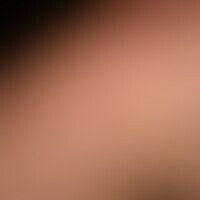
Stevens-johnson syndrome L51.1
Stevens-Johnson syndrome: Acutely occurring vesicular exanthema with characteristic, bull's-eye erythema, plaques and blisters as well as extensive, painful erosions of red lips, lip mucosa, tongue and gingiva in an 18-year-old woman. Clear general feeling of illness.

Eyelid dermatitis (overview) H01.11
Chronic contact allergic eyelid dermatitis: therapy-resistant, chronic dermatitis of the eyelid caused by beta-blocker-containing eye drops (for glaucoma). Only by changing the therapeutic agent could a complete healing of the chronic dermatitis be achieved. In the meantime, a 1% hydrocortisone vaseline was applied twice a day.
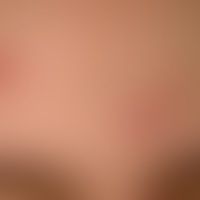
Early syphilis A51.-
Early syphilis: papular syphilide, acne-like clinical picture with disseminated non-itching, occasionally eroded, scaly papules.
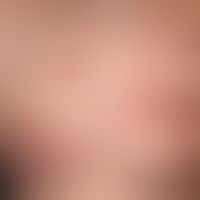
Acne conglobata L70.1
Acne conglobata: inflammatory, also abscessing nodules, bowl-shaped atrophic scars. continuous course of acne since puberty. the skin symptoms are combined with severe acne inversa of the axillae and inguinal regions.




